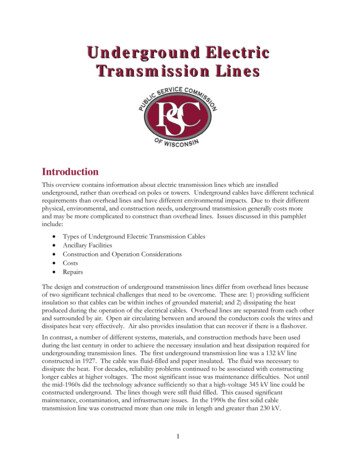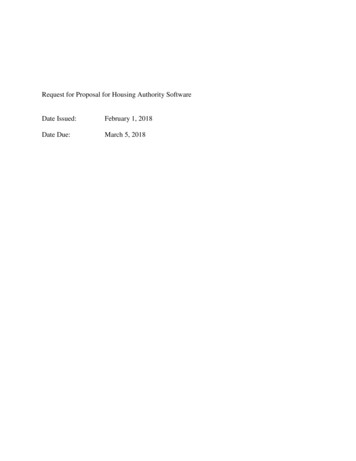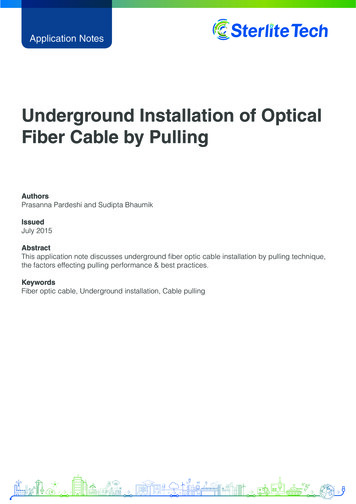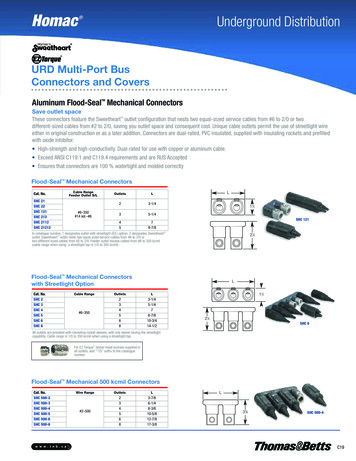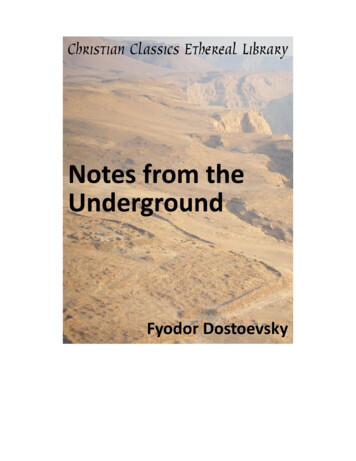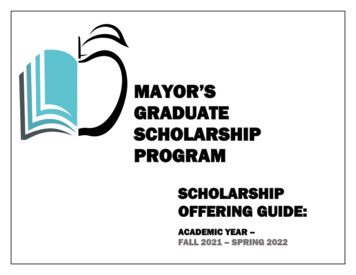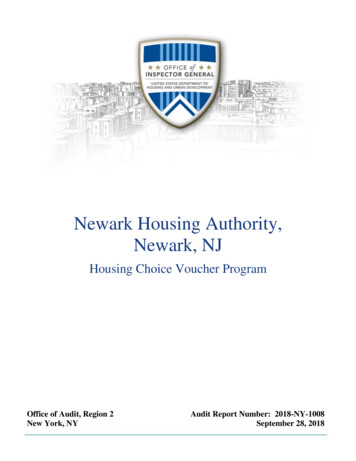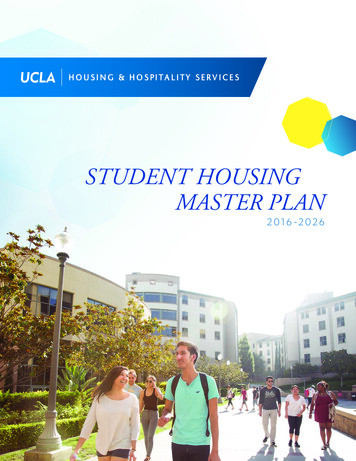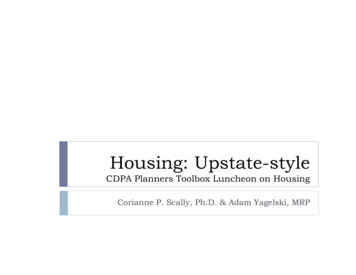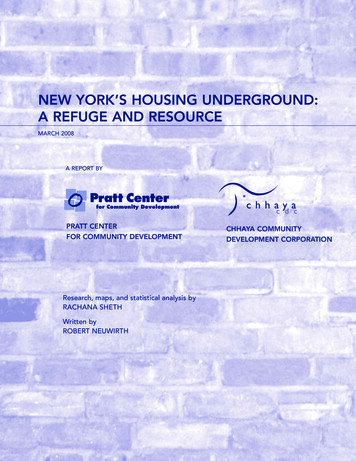
Transcription
NEW YORK’S HOUSING UNDERGROUND:A REFUGE AND RESOURCEMARCH 2008A REPORT BYPRATT CENTERFOR COMMUNITY DEVELOPMENTResearch, maps, and statistical analysis byRACHANA SHETHWritten byROBERT NEUWIRTHCHHAYA COMMUNITYDEVELOPMENT CORPORATION
Pratt Center for Community Development379 DeKalb AvenueBrooklyn, NY attcenter.netChhaya Community Development Corporation37-43 77th Street, 2nd FloorJackson Heights, NY rg
New York’s Housing Underground: A Pratt Center/Chhaya Study 1EXECUTIVE SUMMARYBetween 1990 and 2000, New York City gained 114,000apartments that are not reflected in the official numberof certificates of occupancy the City granted for newconstruction or renovation. Many more have almost certainly been created since. These phantom apartmentsare the city’s housing underground: units that have beencreated in spaces that are not approved for living. Theyinclude private homes that have been cut into roominghouses, two-family homes with unauthorized basementapartments that house an illegal third family, unapprovedresidential conversions of commercial lofts, and othertypes of unlawful construction.Research by the Pratt Center for Community Development(Pratt Center) and Chhaya Community DevelopmentCorporation (Chhaya) shows that these units predominatein neighborhoods on the outskirts of the city, in Queens,Brooklyn, and the Bronx. In these communities, populated by large numbers of recent immigrants, the existenceof unauthorized apartments is controversial. Many neighbors view these units as drains on neighborhood services,as indications of an uncounted population using schools,hospitals, streets, and services. The people who live inthese units, understandably, see things differently. Forthem, these units are necessary, a crucial resource in acity sorely lacking in affordable alternatives.In this report, the Pratt Center and Chhaya outline howthis fact provides the city government with an opportunity. It is possible to legalize these basement units whileensuring public safety, restricting additional density underthe zoning code, and ensuring that no neighborhoodswill be unduly burdened with overcrowded schools andservices. This would allow many of these units, which arecurrently outside city rules and potentially dangerous totenants, landlords, and the communities around them, tobe made safer and to become part of the city’s formalhousing stock.Such “accessory dwelling” units have been legalized inmany cities and communities, from Santa Cruz, California,to Long Island, New York. Allowing them to become partof the legal housing stock in New York City will benefitlandlords, tenants, the neighborhoods they live in, andthe city as a whole.The Pratt Center and Chhaya offer the following recommendations to begin to bring these unauthorized unitsinto the city’s regulatory system:1) The City should create an “accessory dwelling unit”category within the building and zoning codes, whichwould allow many of these currently illegal units tobe legalized.2) The City should offer landlords who agree to legalizetheir basement apartments as accessory dwelling unitsa reasonable (e.g., 12–18 month) grace period duringwhich they will not be subject to penalties for illegaloccupancy under the Building Code.3) The City should offer landlords who offer to legalizetheir basement apartments for existing tenants atexisting reasonable rents technical assistance andfinancial incentives to make the necessary repairs.4) The City and state should enable violations of accessory dwelling unit provisions to be heard in HousingCourt, rather than at the Environmental ControlBoard, thus guaranteeing that landlord and tenantneeds are taken into account. The City should alsoconsider community mediation and enforcement,so as not to burden the legal system.5) The City should establish community-based task forcesin the neighborhoods that have the most unauthorizedhousing units to follow the impact of the accessorydwelling unit measure and the role that the housingunderground plays in other neighborhood issuessuch as traffic, parking, schools, and hospital usage.6) The City should push for passage of legislation requiring all sellers of buildings in the five boroughs to certifythat their homes meet all applicable housing, zoning,and building codes before the sale is consummated.
2 New York’s Housing Underground: A Pratt Center/Chhaya StudyOVERVIEW AND ANALYSISIn almost all of New York’s neighborhoods, people ofmodest means are on housing life support. Simply put,there is a housing gap in New York. Over the past 25years, the growth in population has dramatically outpaced the number of units that have been built, evenwith the building boom of the last 10 years. The result isa shockingly low vacancy rate, around 3 percent in 2005(anything under 5 percent constitutes a housing emergency, according to state law). And the median rent inthe city is rapidly approaching 1,000 a month. The city’spopulation (currently approximately 8.2 million) is projectedto rise to 9.1 million by 2030, and it is unlikely that thenumber of available affordable units will expand to meetthat need without some innovative approaches to housing.The housing crisis falls especially hard on immigrants, whocome to the city seeking a better life, only to find thatgetting by here is incredibly expensive. Dismal housingconditions for many immigrants is a story as old as NewYork itself, and the subject of a landmark wave of reformin the early 20th century. But New York in the 1990s sawimmigration on scale it hadn’t seen since the 1910s. Morethan one million immigrants arrived in New York City from1990 to 2000. Another 593,000 settled between 2000and 2007. Many have ended up living in overcrowded,illegal, and sometimes unsafe conditions. Nonetheless,they have brought new energy and investment to manyneighborhoods that have long been stagnating.The City, under Mayor Michael Bloomberg, has madea laudable commitment to building affordable housing.But the supply of affordable units is expected to remainextremely tight despite this plan.and tenants not daring to report possible unsafe conditionsfor fear of eviction, it’s not easy to quantify just how manyof these underground units exist and what they look like.The best way to count these illegal units is to look forchanges in the housing stock that are not reflected infederal Census data or in the City’s records on renovations and certificates of occupancy. Our analysis buildson a methodology developed by Frank Braconi and theCitizens Housing and Planning Council. The differencebetween the number of apartments reported to be available for occupancy in the 1990 Census and the numberreported to be available in the 2000 Census should yieldthe number of units constructed over the decade. Instead,the Census data shows a surplus. An analysis by the PrattCenter for Community Development shows 114,000apartments that are unaccounted for, having simplyappeared in 2000 without any evidence that they werebuilt during the decade. These units represent the city’shousing underground—and, as many residents may haveavoided contact with Census enumerators, the true housing underground is likely larger. Even so, using the Censusfigure as a bare minimum, the housing undergroundaccounted for more than half of the housing producedin the city in the 1990s.More recent housing data from 2005, though not directlycomparable to the Census counts in 1990 and 2000, suggests a persistence of unaccounted-for new housing units,despite a boom in housing production that unleashednearly 100,000 new certificates of occupancy citywide.From 1990 to 2005, the four boroughs outside Manhattanhad roughly 103,000 unrecorded new units, or nearly 40percent of all the new housing created during that period. This Census data provides one of the most clear andaccurate snapshots of the city’s stock of illegal apartments.The combination of an increasing population and adecreasing number of affordable apartments availablehas led to the creation of a large number of illegal units.Essential, these apartments were created without properconstruction permits and without regard for some of therules of the city’s Building, Housing, and Zoning Codes.These units might be too much below grade (see “CaseStudy: A Breezy Getaway” on page 4), or their ceilingsmight be too low, or the windows might be too small tofunction as legal fire exits. But, despite these conditions,the continuing tight housing market has made theseunits desirable residences.Close to 95 percent of the housing underground createdin the 1990s is in three boroughs: Queens, Brooklyn, andthe Bronx. Queens claims 48,000 of these illegal units,representing 73 percent of all housing built in the boroughduring that decade. Brooklyn was second, with 38,000apartments, and the housing underground in Kings Countyrepresented 61 percent of the new housing constructedthere during the decade. The Bronx weighed in with22,000 apartments in the housing underground.It’s hard to track how many of these illegal apartments existin New York City. With owners unwilling to reveal that theyhave these units for fear of being cited with a violationThis furtive development accounts for approximately4 percent of the city’s housing stock. It is likely thatbetween 300,000 and 500,000 New Yorkers
New York’s Housing Underground: A Pratt Center/Chhaya Study 3Table 1: Top 10 Neighborhoods with “Unaccounted for” Units, 1990–2000CITY NEIGHBORHOODSCOMMUNITY DISTRICT RANK NO. OF UNITSCastle Hill/SoundviewEastchester/WoodlawnSouth Jamaica/HollisCanarsie/Bergen BeachQueens Village/BelleroseKew Gardens/Richmond Hill/WoodhavenSouth Ozone Park/Howard BeachSheepshead BayCypress Hills/East NY/Starrett CityEast Flatbush/Remsen 5,048Total units in these 10 districts: 66,629, or 58.4 percent of the citywide total.Map 1: “Unaccounted for” Units, 1990–2000“UNACCOUNTED FOR” UNITSWhile it is impossible to directlycount the number of occupiedhousing units in New York City thatare not certified by the Departmentof Buildings, it is possible to inferhow many of those units have beencreated in recent years by comparing Census counts of occupiedhousing units with the number ofunits that received Certificates ofOccupancy during the same interval.The 2000 Census found New YorkCity had 210,358 more housing unitsthan it did in 1990. Yet during the1990s, the Department of Buildingsrecognized only 139,628 new unitsconstructed or rehabilitated duringthat period—a difference of morethan 114,000.This map shows the neighborhoodsthat had the widest gap betweenthe number of occupied housingunits recorded by the Census during the 1990s and the number officially documented by the City.(or approximately one of every 25 city residents) call thehousing underground home.The growth of the housing underground has been mostheavily concentrated in communities in southern andeastern Brooklyn, the north and east Bronx, and easternQueens. Within those boroughs, the Pratt Center hasdetermined that the housing underground is concentratedin middle class immigrant neighborhoods that are closeto the city’s borders. Table 1 (above) shows the top 10community districts with units in the housing underground.By and large, these areas are near the borders of thecity, as far as you can get from Manhattan without leaving the city. They are not the most impoverished areasbut instead are stable working- and middle-class neighborhoods that are home to numerous immigrant groups.One thing that these communities do have in common,however, is that they have, on average, larger familysizes than in the rest of the city (see Map 2 on page 5).Because these apartments are largely hidden and furtive,there are no accurate statistics on who lives in them. Butthe supposition in these highly immigrant neighborhoods
4 New York’s Housing Underground: A Pratt Center/Chhaya StudyCase Study: A Breezy GetawayIt hardly seems possible that anything about Winneth Chand’s houseis illegal. Her block is too nice: a tidy line of modest two-family housesnear Greenwood Cemetery in Brooklyn. These homes seem so snugand well-maintained that it is hard to believe any violations could exist.And it’s not that her home is squalid or substandard, far from it.Inside and out, her house, which was constructed 81 years ago, isimmaculate, airy, comfortable, and solid. But the City claims that thefinished basement, which was already there when she and her husband,both immigrants from Guyana, bought the building 13 years ago, violates the law. Chand, a nurse’s assistant, doesn’t even rent out the basement. Instead, she uses it as a personal respite: She has asthma, andwhen she opens the front and back doors to the basement, the rushof fresh air is cooling and restorative.“I feel very good down here,” she says as she sits on the couch in thecarpeted living area of her below-grade getaway. “I have seven windowsand two doors in this basement—and they all open.”Nonetheless, someone complained to the Buildings Department, whichinspected and declared that Chand’s basement retreat falls afoul of oneof the City’s seemingly arbitrary rules. Her basement, it turns out, isnot a basement according to law, because it is slightly more than 50percent below grade level. That means that it is a cellar—and residentialoccupancy is not allowed. The kitchen, bathroom, and two bedroomsthat exist below grade, are all illegal.Chand’s basement getaway is not high-priority code violation. There’snothing dangerous about her lower floor. Indeed, if it were a rentalunit, many tenants would consider it more habitable and healthy thanmany legal apartments in the city’s older tenements. But Chand’s breezycellar fails to meet the regulations by only an inch or two—and thismakes it part of the housing underground.is that recent immigrants dominate the tenancy of thehousing underground. There are many reasons to supposethat this is true. Immigrants often fear providing documentation to qualify for public housing or meet the vetting process required by many larger landlords. Further,it is likely that vacancy decontrol and the extremely highcost of new housing has meant that fewer rent-regulatedtenants are leaving their apartments, thus making it lesslikely that new immigrants will find affordable homes inlegal units.Many of the illegal apartments that constitute the housing underground were carved out of little-used spaces(basements, garages, storefronts, attics) and served manypurposes over the years, often as homes for older relatives. Now they have become one of the city’s safety valves:a source of affordable rental housing. Our anecdotal evidence suggests that these illegal apartments rent for asmuch as one third below the market rate. Not surprisingly,many of these New Yorkers are happy with their homes,and some don’t even know that their apartments areconsidered illegal. But their status is precarious, becausea single complaint to the City can cause misery for bothlandlords and tenants.This massive amount of illegal housing has gotten a badname, in part because it is not well understood. Privatehomes carved into dozens of single rooms, individualapartments subdivided into cell-like living spaces—thesekinds of underground dwellings are unsafe, and, at times,they can be downright dangerous. These overstuffedhomes can put undue stress on a home’s wiring andinfrastructure, as was seen in the 1990s when a series oftragic fires in Queens exposed the problem. But theseare not typical portraits of the city’s illegal housing stock.In fact, much of the housing underground provides a safeand reasonable choice for decent housing in a city whereit is hard to find.Another challenge is that the housing underground addsto the burden on neighborhood infrastructure. Schools,hospitals, sanitation, fire protection, parking, traffic congestion, and open space can all be stressed by the largenumber of residents in illegal housing. This is a broaderproblem of population growth in neighborhoods throughout New York City, and especially those with growingimmigrant populations. The physical and social infrastructure needed to support livable neighborhoods has notkept up with population growth.For these and other reasons, residents of the neighborhoods most affected by the housing underground havebecome increasingly vocal in their attempts to shut downthese units. The number of complaints the City hasreceived about these illegal units has tripled. A decadeago, in 1997, there were only 8,000 complaints aboutthe housing underground received by the BuildingsDepartment. In 2005, the City received 24,800 complaints.It should be noted that this data reflects complaints, notproven violations, and it is possible that the number ofcomplaints has increased due to the advent of the 311system that makes it easier to file anonymous complaints.As the discrepancies between Table 2 (page 6) and Table 1(page 3) suggest, the neighborhoods with the most unaccounted for units are not necessarily the source of thegreatest number of complaints or vice versa. By far thegreatest number of complaints arise from two-familyhomes that have been converted to “illegal threes”—nearly 10,000 in 2005 alone. While two-family homesrepresent only 27 percent of the residential structures inNew York City, they represent 40 percent of all conversion complaints.
New York’s Housing Underground: A Pratt Center/Chhaya Study 5Map 2: Average Household Size in 2000
6 New York’s Housing Underground: A Pratt Center/Chhaya StudyPenalizing owners has had little impact on the housingunderground. In 1997, the City increased penalties forillegal conversions, but there was no reduction in complaints. Currently the fine is set at 1,000 a day for eachunit in a building, with a maximum accrued fine of 25,000. On second offense, the maximum fine can riseto 45,000. Cases regarding the housing undergroundare heard by the City’s Environmental Control Board, anadministrative tribunal that adjudicates the City’s qualityof life laws involving everything from sanitation and foodsafety to asbestos, air quality, and graffiti.The growth of the housing underground is a marketresponse to the shortage of affordable housing and theincrease in the city’s population, as well as homeowners’need to pay often high mortgages. Finding ways to dealwith the growth of illegal units needs to be a city priority,yet it is clear that criminalizing the housing undergroundhas not reduced its scope. The City should look formechanisms to identify illegal apartments, determinewhich ones are safe, and make efforts to incorporatethem into the framework of traditional building andhousing codes so they can be accepted and legally evaluated without fear of undue penalty to homeowners orsummary eviction of tenants. What follows is a six-pointaction plan that would bring a large chunk of the housingunderground out into the open air and provide a methodfor formalizing these currently illegal units.Table 2: Top 10 Neighborhoods with Illegal Conversion Complaints in 2005CITY NEIGHBORHOODSCOMMUNITY DISTRICT RANK COMPLAINTS 2005South Ozone Park/Howard BeachQN10Jackson Heights/N. Corona/E. ElmhurstQN3Kew Gardens/Richmond Hill/WoodhavenQN9Elmhurst/CoronaQN4South Jamaica/HollisQN12Ridgewood/MaspethQN5Downtown Flushing/Bay Terrace/College Point QN7Queens Village/BelleroseQN13Astoria/RavenswoodQN1Cypress Hill/East New York/Starrett 2481,219791729Table 3: Building Class and Illegal Conversions Complaints in 2005COMPLAINTS 2005MANHATTAN STATEN ISLAND BRONX BROOKLYN QUEENS NYCOne FamilyTwo FamilyWalk-up ApartmentsElevator ApartmentsOther : New York City Department of Buildings
New York’s Housing Underground: A Pratt Center/Chhaya Study 7RECOMMENDATIONSIn order to address the challenges posed by New YorkCity’s housing underground in a manner that does themost possible to ensure a supply of safe, decent, affordable housing, and to address issues of safety, health,and neighborhood infrastructure, the Pratt Center forCommunity Development and Chhaya CommunityDevelopment Corporation offer the followingrecommendations:1) The City should add a new category of residence tothe building, housing, and zoning codes, an accessorydwelling unit (ADU). It would apply in all neighborhoods of the city and all zoning districts, even R1 andR2 districts, areas that currently limit housing to standalone single-family residences. Essentially, this newcategory of the code would allow units that receivesufficient light and air to exist legally, even if they areless than 50 percent above grade level, as long asthey do not add to the built square footage of thestructure. To maximize public safety, the ADU framework would be created by a panel of expert architects, engineers and planners, who would specify whatsize windows in ground-level apartments would constitute an appropriate and safe secondary means ofegress in case of a fire. The State and City may alsocontemplate changing the Multiple Dwelling Law,which currently prohibits frame buildings from becoming legal multiple dwellings, if a panel of architects andengineers deems this a wise choice. Undoubtedly,there are many frame two-family structures that arecurrently housing three families. Rather than allowingthese units to remain underground, the City shoulddetermine what kinds of improvements would beneeded to make it safe to allow greater density inexisting frame buildings. The City could also chooseto launch the ADU program in phases, by creatingpilot legalization projects in neighborhoods that havehigh numbers of illegal units. This would allow officialsthe opportunity to study the impact of legalizationbefore applying it citywide.2) In combination with establishing new ADU code provisions, the City should allow landlords a reasonable(e.g., 12–18 month) grace period after coming forward during which time they can make the alterationsto convert their non-conforming apartments into legalaccessory dwelling units while facing no penaltiesor inspections.ADUs in the USANew York City would not be inventing the idea of accessory dwellingunits. Many municipalities in the U.S. have adopted the concept toallow ancillary apartments, often called “granny flats,” in single-familydistricts.California, Connecticut, Illinois, Massachusetts, Oregon, Vermont,Florida, Washington, D.C., and Washington State have all adoptedstrategies allowing accessory dwelling units in many fast-growing areas.Santa Cruz, California, provides an example of a proactive approachfor allowing ADUs. Faced with high housing costs and a growingpopulation, the city adopted an ADU ordinance in 2001 to allowunits in garages and basements and within homes. The city providedloans to homeowners and incentives for keeping the units affordable,and it developed manuals, design guides, and workshops for homeowners. This program won several awards from the American PlanningAssociation.It will not be possible simply to copy legislation from elsewhere andapply it to New York. With greater density, stronger fire codes, anddiffering construction standards, New York’s use of an accessorydwelling unit measure will undoubtedly require a different design thanis used in other municipalities. Also, New York City could choose tocreate a process that would allow for legalization of already existingADUs, while choosing to forbid the addition of new square footageof residential space.3) One key element of the program must involve theretention of current tenants at current affordablerents. To this end, the City should offer a program oftechnical and financial assistance for landlords whoagree to retain their existing tenants at affordable rents.This is necessary because it has been estimated that,including professional fees for architecture, engineering, permits, and legal services, it may cost 10,000 to 15,000 to legalize some accessory dwelling units. Giventhe relatively high cost that may be attached to legalizing unauthorized apartments under ADU provisions,the City should also consider providing tax abatementsand other subsidies to encourage landlords to participate and to prevent rent increases to tenants. If alandlord receives a tax deal or a subsidy for legalizingan accessory unit, he/she should be required to recognize the existing tenants and keep the unit affordable.The mechanism to ensure affordability could be througha signed agreement recorded in the land records, or alegally binding agreement to make the accessory unitssubject to the rent stabilization laws.
8 New York’s Housing Underground: A Pratt Center/Chhaya Study4) Once a unit has been legalized as an ADU, all complaints about conditions should be heard in housingcourt, as is true of all other landlord/tenant actions,rather than by the Environmental Control Board. Thiswill put such housing actions before judges who havethe relevant experience and will reduce the burden onthe administrative tribunal that handles quality of lifecomplaints. But, to save court time and money, theparties should be encouraged to submit to communitymediation. Many of the disputes and violations in thehousing underground do not involve structural problems or violations that put occupants in immediatedanger. Thus, mediation is an appropriate approach.This mediation effort could be organized by the Cityor could be done in the community, in concert withcommunity groups. As the law stands now, tenants areoften afraid to ask for housing code inspections or toengage their landlords in discussions about repairs forfear that they will ultimately be evicted due to theirapartment’s illegal status. A mediation program wouldprovide more protections for tenants who come outfrom the underground and insist that their apartmentsbe appropriately repaired and maintained.5) The communities that have the bulk of these illegalunits also need to be involved. There needs to be aprocess for helping neighborhoods address the issueof increased population in the housing undergroundas it affects schools, traffic, parking, infrastructure,health care, and other issues. The City should form atask force or roundtable of stakeholders to promoteawareness of City codes and rules, to evaluate andstudy the issue, to monitor the implementation of theaccessory dwelling unit program, and to addressissues of neighborhood crowding and infrastructure.By creating a community-based roundtable the Citycan hold education sessions for landlords and tenantsand introduce them to the opportunities inherent inthe accessory dwelling unit program. Furthermore, theroundtable could end the unfairness of the complaintsystem. As the system currently stands, the only homeowners who face penalties are the ones who havebeen reported to the Buildings Department. Yet manyother buildings that have apartments in the housingunderground will never be prosecuted because noone ever complains. Empowering the roundtable todo a house-by-house census on certain blocks wouldbe a way of making the process more fair to all owners and tenants. Finally, the roundtable could also takeon the task of studying some of the other types ofunits in the housing underground, such as illegalrooming houses and small dwellings cut up into a larger number of illegal units. While they are not as easyto incorporate into the legal framework as “illegalthrees,” the community roundtables could considerother approaches that would ensure public safetywhile protecting vulnerable tenants from eviction.6) The City should support legislation, which has alreadybeen proposed in the City Council, that would mandate that sellers in real estate transactions certify theresidential status of the properties they are selling atthe real estate closing and sign an affidavit affirmingthat the building meets the requirements of the zoningcode. This would go a long way to ensuring that allbuyers are clear, at least at the time they purchasetheir buildings, how many legal units are inside thehomes they are purchasing.By creating a new provision for accessory dwelling units,by providing incentives for landlords to keep their accessory dwelling units affordable, by allowing a clear pathto court for disputes that may arise with ADUs, and byempowering stakeholders to control the program, NewYork will gain an urgently needed resource to help solveits affordable housing crisis. Reliable information onhousing occupancy can also help community boards andpublic officials in planning for schools, roads, hospitals,infrastructure, traffic improvements, and other vital services.Accessory apartments could become one of the key coping strategies for tenants who are priced out of thehousing market. And they are coping strategies for landlords, particularly new buyers who are buffeted byincreasing taxes, increasing mortgage interest rates, andskyrocketing home prices, and are looking for a way todefray these high costs.It is time for the City to incorporate these technically illegal city dwellings into the legal framework. An accessorydwelling unit framework will bring a substantial portionof the city’s large housing underground up above groundand make it an official part of the city. This will be a boonto public health and safety, residential security, andorderly community growth.
ABOUT THE PRATT CENTER FOR COMMUNITY DEVELOPMENTThe Pratt Center works for a more just, equitable, and sustainable city for all New Yorkers,by empowering communities to plan for and realize their futures.As part of Pratt Institute, we leverage professional skills—especially planning, architecture,and public policy—to support community-based organizations in their efforts t
avoided contact with Census enumerators, the true hous-ing underground is likely larger. Even so, using the Census figure as a bare minimum, the housing underground accounted for more than half of the housing produced in the city in the 1990s. More recent housing data from 2005, though not directly comparable to the Census counts in 1990 and .
